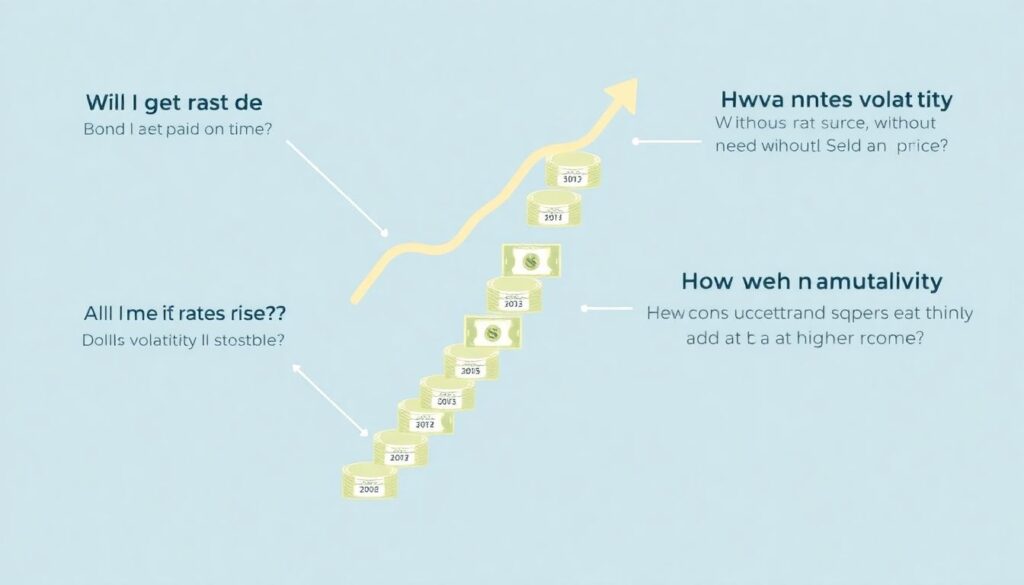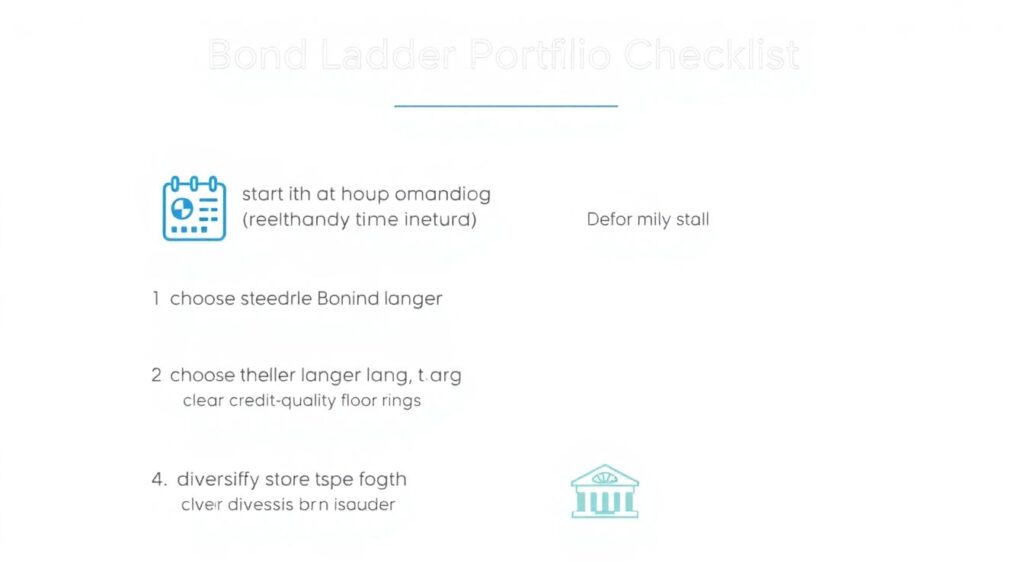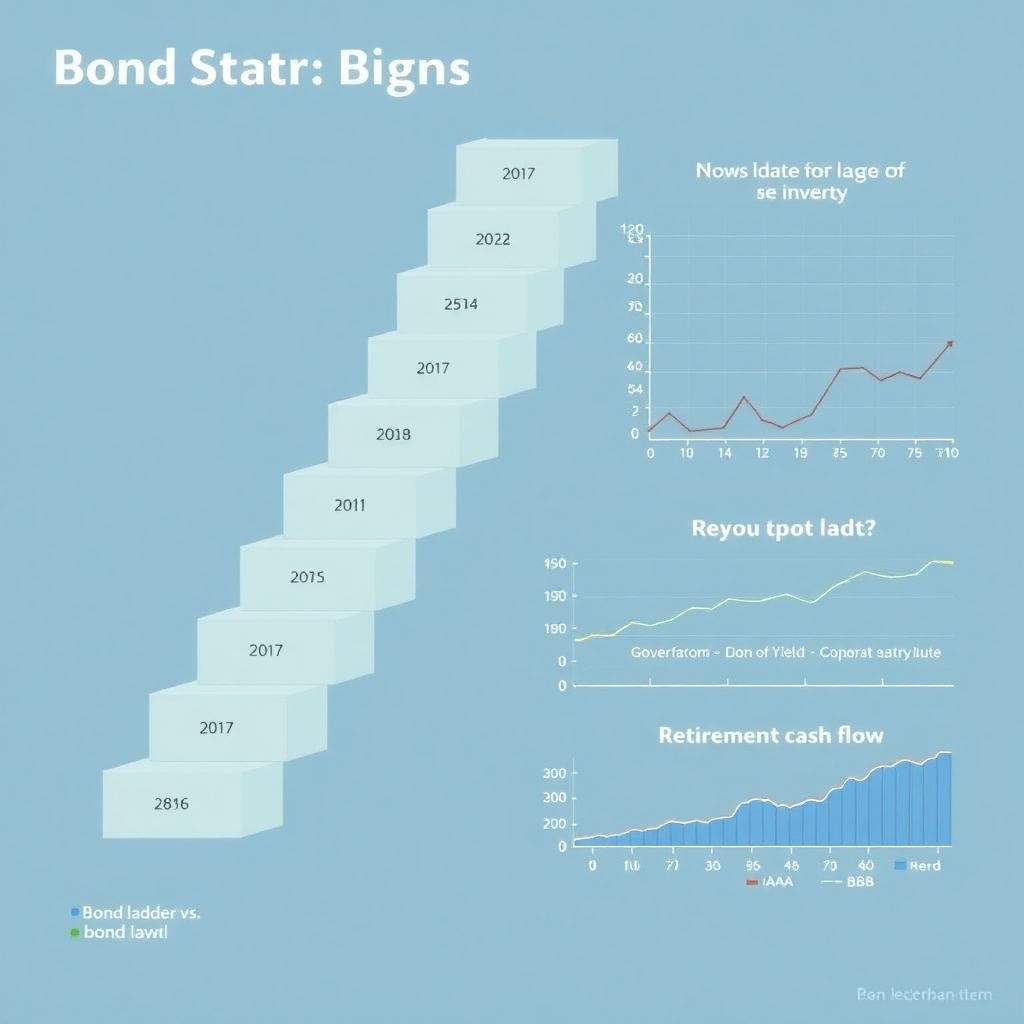What a Bond Ladder Actually Is
A bond ladder is a series of bonds with different maturity dates, spaced out like the rungs of a physical ladder. Instead of putting all your money into one 10‑year bond, you might buy bonds maturing in 1, 3, 5, 7 and 10 years. As each bond matures, you can either spend the cash or reinvest at the far end of the ladder. That rolling process makes a bond ladder strategy for retirement income feel more predictable than trying to time interest rates or chase yield.
Imagine a simple text diagram of a five‑year ladder:
Year 1: [####]
Year 2: [####]
Year 3: [####]
Year 4: [####]
Year 5: [####]
Each block is a bond, and every year one block “falls off” and turns into cash. You decide whether that cash goes into living expenses or into a new bond that extends the ladder. This visual helps to see why people talk about bond ladders as a rhythm of cash flows rather than a single investment bet.
Key Terms Without the Jargon Fog
Before you build anything, it helps to rename the buzzwords into plain English. A “maturity date” is simply the day the bond pays you back its face value. The “coupon” is the interest payment you get along the way, usually twice a year. Yield to maturity is the total return you’d earn if you hold the bond to the end and all coupons are paid on time. With a ladder, you mostly care about when the maturities fall and how much cash they drop into your account.
There are two main bond types you’ll meet. Government bonds (like Treasuries) are considered safer but usually pay less. Corporate bonds are issued by companies and pay higher interest because there’s more risk the issuer might run into trouble. A corporate bond ladder investment strategy mixes different issuers and sectors so that one company’s bad year doesn’t wreck your whole income plan. Rating agencies (AAA, BBB, etc.) help you judge credit risk, but they’re guides, not guarantees.
Why People Use Bond Ladders for Stable Income

The best bond ladders for stable income all try to solve three everyday worries: “Will I get paid on time?”, “What if rates rise?”, and “How much volatility can I stomach?”. Regular maturities give you a built‑in cash source without needing to sell at a bad price. If interest rates climb, the bonds that mature sooner can be reinvested at higher yields. If rates fall, your longer bonds keep paying the older, better coupons. It’s a slow, mechanical way to manage uncertainty.
For someone near retirement, stability often beats maximum profit. Instead of guessing when to move in and out of bond funds, you map your next 5–15 years of expected cash needs and align bond maturities to them. That’s how to build a bond ladder portfolio that feels like a paycheck replacement: the combination of coupons plus maturing principal can roughly match your monthly or yearly spending. It’s not magic; it’s just matching dates and amounts in a disciplined, repeatable pattern.
How a Simple Ladder Works in Practice
Say you have $100,000 and want a 5‑year ladder. You split it into five chunks of $20,000 and buy: a 1‑year bond, 2‑year, 3‑year, 4‑year and 5‑year. In year one you receive coupons from all five bonds, and at the end of the year the 1‑year bond matures, returning $20,000. If you’re still in the accumulation phase, you might reinvest that $20,000 into a new 5‑year bond, so the ladder now runs from year 2 to year 6.
Text diagram after the first reinvestment:
Start: 1y–2y–3y–4y–5y
After 1 year: 2y–3y–4y–5y–6y
Each year, the leftmost rung pays back principal, and you add a new rung on the right. During retirement, you may instead spend part of that maturing principal and reinvest the rest. The structure is flexible: you can make the rungs closer (every 6 months) or wider (every 2–3 years) depending on how finely you want to match your expected expenses.
Comparing: Bond Ladder vs Bond Fund – Which Is Better?

The classic question is bond ladder vs bond fund which is better, and the honest answer is “it depends what problem you’re trying to solve.” With a bond fund, you own shares in a pool of bonds that’s constantly changing. You get diversification and convenience, but you don’t control exact maturity dates, and your income can fluctuate as the manager trades. Prices move daily, and if you need cash during a bad market, you might lock in losses.
A ladder, by contrast, behaves more like a schedule than a market product. You choose each bond’s maturity upfront, so you know when principal comes back. Market prices still move, but if your plan is to hold to maturity, the day‑to‑day noise matters much less. The trade‑off is that you must manage purchases, maybe accept lower diversification if the portfolio is small, and pay trading spreads. For people who value predictability of cash flow over simplicity, the added control is often worth the effort.
Designing a Ladder: Practical Steps
Here’s a straightforward blueprint for how to build a bond ladder portfolio without turning it into a science project:
– Decide the time horizon: 5, 10, or even 20 years
– Choose rung spacing: yearly, every 2 years, or custom
– Pick the mix: government vs corporate vs municipals
– Set minimum credit quality and max size per issuer
– Plan whether you’ll reinvest principal, coupons, or both
Once those decisions are clear, you translate them into actual trades. Suppose you want 10 years of partial income coverage. You might start with maturities at years 1 through 10, roughly equal amounts in each rung. Over time, you can adjust: if rates seem low, keep ladder length shorter; if rates are attractive, extend out. The core idea doesn’t change: maturities staggered over time, matching reasonably predictable spending.
Rate Risk: How a Ladder Cushions the Blows
Interest rate risk scares people because rising rates make existing bonds drop in price. Ladders soften that risk in a mechanical way. The shorter rungs mature soon, freeing cash to reinvest at the new, higher yields. The longer rungs, meanwhile, keep earning the older, higher coupons if rates fall later. You’re never all‑in on one single rate environment. This doesn’t eliminate risk, but it spreads it over time, which is often enough to sleep better at night.
Picture another text diagram showing reinvestment over time:
Year 0: 1–3–5–7–9
Year 2: 1–3–5–7–9
Year 4: 1–3–5–7–9
The labels “1,3,5,7,9” keep sliding forward as maturing bonds are rolled into new long‑dated issues. Each roll happens at whatever yields prevail at that moment. You’re accepting you can’t forecast rates and instead using structure to average into them across different years and cycles. That humility is a key hidden advantage of ladders.
Credit Risk and a Corporate Bond Ladder
When you move from government to corporate bonds, yield improves but so does the risk of default. A corporate bond ladder investment strategy tackles this by diversifying across issuers and sectors and by setting rules. For instance, you might allow only investment‑grade bonds, cap any single issuer at 5% of the ladder, and avoid highly cyclical industries for the rungs that sit closest to your retirement years, where failure would hurt the most.
In practice, you can think in layers. Near‑term rungs (next 3–5 years) often lean on safer bonds—Treasuries, high‑grade corporates or solid municipal bonds—because you rely on them for near‑certain cash. Middle rungs can take a bit more credit risk for higher income, while the longest rungs can mix in carefully selected BBB names. The point is not to juice returns at all costs, but to trade a little extra risk for a noticeable bump in yield without compromising your core spending plan.
bond ladder strategy for retirement income: Putting It to Work
A practical bond ladder strategy for retirement income starts with your budget, not with bond screens. Estimate how much of your yearly spending must be rock‑solid—housing, food, basics—and how much can be flexible. Maybe you decide bonds should reliably cover 60% of that number, with the rest coming from equities, pensions or part‑time work. That target cash flow becomes the anchor for choosing ladder size, average yield, and how many years of expenses you want pre‑funded.
Then you map cash flows. For each year in retirement, look at:
– Coupons expected from existing bonds
– Principal from maturing rungs
– Non‑bond income like Social Security or dividends
– Any large one‑off expenses you can foresee
If there’s a shortfall in a given year, you extend or thicken the corresponding rung. Over time, you can skim excess coupons to rebuild longer rungs or to refill a cash reserve. The best bond ladders for stable income are revisited every year or two: you glance at the calendar, check actual spending, shift a bit of allocation if needed, but keep the basic staircase intact.
How to Combine Ladders and Bond Funds
You don’t have to pick sides in the bond ladder vs bond fund which is better debate; mixing them can be smart. Many retirees use a ladder to cover the first 5–10 years of essential spending, then keep additional bond exposure in low‑cost, diversified funds for the long run. The ladder handles timing‑sensitive cash needs, while funds help with broad diversification and reinvestment of smaller amounts that would be expensive to buy as individual bonds.
One simple approach is to define a “safety zone” and a “growth zone.” The safety zone is the ladder—transparent, date‑matched cash flows. The growth zone holds bond and stock funds for inflation protection and potential upside. Each year, as rungs mature, you can decide whether to refill the ladder, top up funds, or just spend the cash. That decision can reflect market conditions, but it’s made within a structured framework, not as a spur‑of‑the‑moment hunch.
how to build a bond ladder portfolio: Checklist

To pull everything together, here’s a streamlined checklist for how to build a bond ladder portfolio that you can actually maintain:
– Start with your spending map and time horizon
– Decide the ladder length and spacing of rungs
– Choose bond types and a clear credit‑quality floor
– Diversify by issuer, sector, and maturity date
– Automate reinvestment rules as much as possible
As you implement, keep records that match each bond to a goal year. A simple spreadsheet with columns for maturity date, coupon, expected annual cash, and linked spending purpose goes a long way. Revisit it once a year to roll maturing bonds, adjust for new goals, or react to major interest‑rate shifts. Over time, the structure becomes familiar, and the ladder stops feeling like a complex “product” and more like a straightforward household cash‑flow tool you happen to run with bonds.

